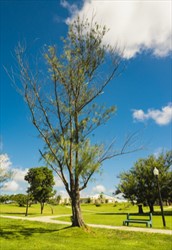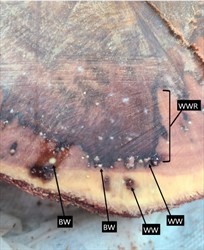A disease associated with two pathogens, bacterial wilt, Ralstonia solanacearum, and Ganoderma australe; the involvement of the termite, Nasutitermes takasagoensis, was also considered to be involved in spreading the disease, but now this is thought unlikely.
Under a revised classification system (2005), and based on DNA sequencing, Ralstonia solanacearum has been divided into four groups, reflecting geography (phylotypes), and further by genetic sequence of an important gene (sequevars). By this method the strain of Ralstonia solanacearum infecting Casuarina in Guam is phylotype 1 (Asia). It is equivalent to biovar 3 on the system that separates strains on their use of certain carbohydrates.






